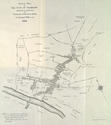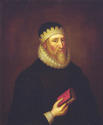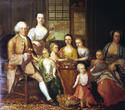 The Reformation of 1560 saw Scotland renounce Roman Catholicism and embrace Protestantism. It was particularly significant for Glasgow. This was a "bishop's burgh", a privileged town which enjoyed the right to hold markets and participate in foreign trade. It was closely managed by the archbishops of Glasgow: they chose the provost and the bailies, the magistrates who presided over the burgh court and the town council.
The Reformation of 1560 saw Scotland renounce Roman Catholicism and embrace Protestantism. It was particularly significant for Glasgow. This was a "bishop's burgh", a privileged town which enjoyed the right to hold markets and participate in foreign trade. It was closely managed by the archbishops of Glasgow: they chose the provost and the bailies, the magistrates who presided over the burgh court and the town council.
Episcopal Control
 Glasgow became a royal burgh in 1611, directly subject to the crown. Normally, royal burghs appointed their own magistrates but in Glasgow the archbishops continued to control appointments, limited only by Parliament's stipulation that all provosts in all burghs had to be resident merchant burgesses.
Glasgow became a royal burgh in 1611, directly subject to the crown. Normally, royal burghs appointed their own magistrates but in Glasgow the archbishops continued to control appointments, limited only by Parliament's stipulation that all provosts in all burghs had to be resident merchant burgesses.
 Ironically, it was at the meeting in Glasgow of the General Assembly of the Church of Scotland in 1638 that an attempt was made to abolish episcopal church governance, setting in motion events that plunged the British Isles into civil war for almost fifteen years. Even these crises did little to advance Glasgow's ambitions, as the Presbyterian and Cromwellian governments of the 1640s and 1650s continued to keep a firm grip on the burgh. Fortunately, despite the burgh's strategic position at the lowest crossing point on the Clyde, the wars largely passed it by and it was occupied only briefly by a hostile but complacent royalist army. Unlike Dundee and Aberdeen, it was not sacked.
Ironically, it was at the meeting in Glasgow of the General Assembly of the Church of Scotland in 1638 that an attempt was made to abolish episcopal church governance, setting in motion events that plunged the British Isles into civil war for almost fifteen years. Even these crises did little to advance Glasgow's ambitions, as the Presbyterian and Cromwellian governments of the 1640s and 1650s continued to keep a firm grip on the burgh. Fortunately, despite the burgh's strategic position at the lowest crossing point on the Clyde, the wars largely passed it by and it was occupied only briefly by a hostile but complacent royalist army. Unlike Dundee and Aberdeen, it was not sacked.
 The Restoration of the monarchy in 1660 and of the episcopacy in 1662 brought a full resumption of the archbishops' rights to appoint the town's magistrates. It was an incongruous situation for a burgh whose rapidly expanding economy confirmed it had outgrown any need for the patronage of its archbishops. Yet, despite the popularity of the anti-episcopal covenanting movement in Glasgow and elsewhere, both the episcopacy and the Stuart monarchy from which it derived its authority appeared secure as the 1680s drew to a close.
The Restoration of the monarchy in 1660 and of the episcopacy in 1662 brought a full resumption of the archbishops' rights to appoint the town's magistrates. It was an incongruous situation for a burgh whose rapidly expanding economy confirmed it had outgrown any need for the patronage of its archbishops. Yet, despite the popularity of the anti-episcopal covenanting movement in Glasgow and elsewhere, both the episcopacy and the Stuart monarchy from which it derived its authority appeared secure as the 1680s drew to a close.
Self-Governance
 William of Orange's invasion of England in late 1688 changed everything. The failure of the Scottish bishops to pledge William their support heralded the end of episcopal governance and, in 1690, Glasgow's town council finally gained the right to elect the burgh's provost and bailies. Glasgow had finally ceased to be a dependent mediaeval burgh and had become an early-modern town with full rights of self-governance.
William of Orange's invasion of England in late 1688 changed everything. The failure of the Scottish bishops to pledge William their support heralded the end of episcopal governance and, in 1690, Glasgow's town council finally gained the right to elect the burgh's provost and bailies. Glasgow had finally ceased to be a dependent mediaeval burgh and had become an early-modern town with full rights of self-governance.
 Constitutionally, Glasgow was now the equal of Edinburgh, but the capital remained the pre-eminent royal burgh in Scotland, in terms of both size and wealth. However, since the Reformation, Glasgow had also been closing the economic gap on its east coast rival.
Constitutionally, Glasgow was now the equal of Edinburgh, but the capital remained the pre-eminent royal burgh in Scotland, in terms of both size and wealth. However, since the Reformation, Glasgow had also been closing the economic gap on its east coast rival.
Economy
 In 1557, Glasgow was ninth in the national tax assessments, paying only 2 percent of the taxes levied on the burghs. Even Ayr was paying slightly more though, significantly, the remaining seven burghs ahead of Glasgow were all on the east of Scotland, where access to the lucrative continental European markets was easier. Edinburgh was top of the league, paying by far the most (25 percent), more than double that of its nearest rivals, Dundee and Aberdeen.
In 1557, Glasgow was ninth in the national tax assessments, paying only 2 percent of the taxes levied on the burghs. Even Ayr was paying slightly more though, significantly, the remaining seven burghs ahead of Glasgow were all on the east of Scotland, where access to the lucrative continental European markets was easier. Edinburgh was top of the league, paying by far the most (25 percent), more than double that of its nearest rivals, Dundee and Aberdeen.
 By 1670, Glasgow had overtaken all except Edinburgh and, in the century that followed, continued to advance its share (though not its ranking). Tax assessments were based on a burgh's assets but, as these were partly based on market revenues, they do give some idea of economic performance. Between 1560 and 1670, the economic balance that had so long favoured the east coast ports began to change in favour of the west. The east had suffered much in the civil wars of the 1640s and while the western burghs such as Ayr, Irvine and Dumbarton were in decline, Glasgow had been busy overcoming obstacles and pursuing new markets.
By 1670, Glasgow had overtaken all except Edinburgh and, in the century that followed, continued to advance its share (though not its ranking). Tax assessments were based on a burgh's assets but, as these were partly based on market revenues, they do give some idea of economic performance. Between 1560 and 1670, the economic balance that had so long favoured the east coast ports began to change in favour of the west. The east had suffered much in the civil wars of the 1640s and while the western burghs such as Ayr, Irvine and Dumbarton were in decline, Glasgow had been busy overcoming obstacles and pursuing new markets.
 The Reformation and the subsequent wars of the 1560s probably produced an initial slump in trade but by 1578, Bishop John Leslie of Ross could assert that Glasgow was "the maist renouned market in all the west, honorable and celebrat". Yet the most that can really be said is that Glasgow was little more than a small successful provincial market town, with a population of perhaps around 4,500. Its merchants and craftsmen served the immediate needs of the burgh and its hinterland and traded with Argyll, the inner western isles and Ireland. This activity was supplemented by occasional sailings to England and France but Glasgow's ability to trade abroad was severely limited. Until the opening up of the canal network in the late 18th century, access to most European markets usually involved overland haulage to and from the ports on the Forth (and sharing profits with their merchants). Even for western trade Glasgow's position, fifteen miles up the Clyde, was far from ideal. The river was barely navigable for twelve of those miles, shallow draught boats having to carry cargoes to and from the larger sea-going vessels anchored in the estuary. These difficulties were compounded by occasional interference, particularly from the royal burgh of Dumbarton.
The Reformation and the subsequent wars of the 1560s probably produced an initial slump in trade but by 1578, Bishop John Leslie of Ross could assert that Glasgow was "the maist renouned market in all the west, honorable and celebrat". Yet the most that can really be said is that Glasgow was little more than a small successful provincial market town, with a population of perhaps around 4,500. Its merchants and craftsmen served the immediate needs of the burgh and its hinterland and traded with Argyll, the inner western isles and Ireland. This activity was supplemented by occasional sailings to England and France but Glasgow's ability to trade abroad was severely limited. Until the opening up of the canal network in the late 18th century, access to most European markets usually involved overland haulage to and from the ports on the Forth (and sharing profits with their merchants). Even for western trade Glasgow's position, fifteen miles up the Clyde, was far from ideal. The river was barely navigable for twelve of those miles, shallow draught boats having to carry cargoes to and from the larger sea-going vessels anchored in the estuary. These difficulties were compounded by occasional interference, particularly from the royal burgh of Dumbarton.
After the Union
The union of the Scottish and English crowns in 1603 produced the first big advance for Glasgow's economy, opening up a very important overland trade in the export of linen and linen yarn in exchange for finished cloths and a miscellany of hardware items. This encouraged the expansion of the town's manufacturing base and allowed the Glasgow merchants to accrue capital for other enterprises.
Nevertheless, the condition of the Clyde remained a problem. During the 17th century several attempts to remove the shallows between the Broomielaw and Dumbuck failed. Various ports on the lower Clyde coast were used, but this involved paying harbour dues and diminished profits. The solution, when it came, was a masterstroke. In 1668, the town council purchased land on the south bank of the Clyde estuary and there began to develop Port Glasgow through which much of the later tobacco trade would be conducted.
Contemporaries agree - Glasgow was a bustling town, its attractiveness enhanced in the 1650s by the fine new University buildings on the High Street. The council strove to improve the infrastructure and the environment, encouraging stone and slate construction of buildings (after two disastrous fires), opening new water wells and accessing reliable coal supplies for a population that numbered about 14,000 by 1670.
Looking Overseas
Glasgow expanded its European markets particularly in the Netherlands and the Baltic and developed links with the English colonies in the West Indies (for sugar) and America (for tobacco). These last were risky activities, all the more so because they contravened the English Navigation Acts which stipulated that the first port of call for colonial trade had to be English. A cyclical link developed between trade and manufacturing, as the capital from commerce was fed into industry and manufactured goods were exported to new markets. Glasgow's manufacturing base was expanded as the restrictive practices of the mediaeval craft fraternities eased, and cottage industry began slowly to give way to factories. The first 'manufactorie' (for woollens) appeared in 1638. Slowly, others followed, resourced and directed by the merchants who, at the same time, were opening up new markets abroad. By 1700 there were several factories producing a wide range of products, from linen to soap and from earthenware to refined sugar - though cottage industries continued to predominate.
Many in Glasgow (and elsewhere) were ruined by the failure of the Darien scheme, the plan to establish a Scottish colony on the Panama isthmus in the late 1690s - indeed, had it succeeded, Glasgow would have been the principal access port. English obstruction was blamed for the calamity and this belief fuelled riots in Glasgow on the eve of the 1707 Union with England. The unpopularity of the Union lay also behind the Shawfield riots of 1725 that, tragically, left nine citizens dead.
Yet, from the economic standpoint, Glasgow now thrived as never before. It launched itself in earnest at the transatlantic trade, becoming a major entrepot which imported raw tobacco and re-exported it to Europe for manufacture, with manufactured goods travelling in the opposite direction. So great was Glasgow's success, that London, Liverpool and other English ports petitioned Parliament complaining of Glaswegian sharp practice. But the trade continued, facilitated by the provision of generous credit to the colonial producers based on anticipated tobacco crop yields. The burgh was not to be distracted by either European wars or Jacobite risings from its enterprising work.
By the 1770s, Glasgow's population was about 60,000, and new suburbs were opening out to the west (Queen Street, Buchanan Street, Jamaica Street), areas favoured by those who, enriched by the tobacco trade, sought to escape the noisome confines of the old mediaeval closes. Glasgow was the pre-eminent port for the European appetite for tobacco, imports of which had risen to over 40 million lbs by 1772. It seemed that nothing could go wrong, but four years later the American colonies declared independence and the tobacco trade stalled. Glasgow's merchants faced a new challenge.